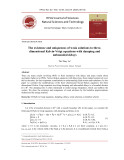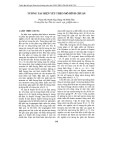
VNU Journal of Science: Mathematics – Physics, Vol. 41, No. 1 (2025) 81-104
81
Original Article
Nonlinear Vibration of Three-Phase Composite
Cylindrical Panels Utilizing Reddy’s
Higher-Order Shear Deformation Shell Theory
Dinh Van Dat*, Tran Quoc Quan, Nguyen Dinh Duc
VNU University of Engineering and Technology, 144 Xuan Thuy, Cau Giay, Hanoi, Vietnam
Received 8th January 2025
Revised 11st February 2025; Accepted 10th March 2025
Abstract: This paper presents a comprehensive analytical framework to characterize the nonlinear
vibration behavior of a three-phase composite. The cylindrical panels are supported by a Pasternak-
type elastic foundation and subjected to combined thermal environment and mechanical loads. A
sophisticated mathematical model is formulated basing on Reddy's higher-order theory to precisely
capture the complex interactions between elastic foundation. The material properties of a three-
phase composite are meticulously determined through analytical expressions that nonlinearly
account for the interactions between the constituent materials. The volume fractions of the
components in the magneto-electro-elastic face sheets are assumed to be equal. Analytical vibration
solutions for the laminated plate are obtained by applying Galerkin method in conjunction with
fourth-order Runge-Kutta method. Numerical results are provided to clarify the impact of geometric
and material parameters, temperature increase, magnetic and electric potentials and elastic
foundations on the vibration behavior of a three-phase composite.
Keywords: Vibration; thermal environment; elastic foundations; three-phase composite; Reddy’s higher-
order shear deformation shell theory. *
1. Introduction
In recent years, polymer composite materials have found extensive applications across various
sectors, including construction, shipbuilding, and civilian uses such as household goods and industrial
plastic production. These materials owe their versatility to reinforcing components like fibers, fabrics,
and particles, each playing a distinct role in enhancing the performance of composite. Fibers and fabrics
________
* Corresponding author.
E-mail address: dinhdatmec@gmail.com
https//doi.org/10.25073/2588-1124/vnumap.4981

D. V. Dat, T. Q. Quan / VNU Journal of Science: Mathematics – Physics, Vol. 41, No. 1 (2025) 81-104
82
are instrumental in boosting the structural load-bearing capacity, while particles contribute to reducing
cracking, minimizing plastic deformation, and improving impermeability and fire resistance. By
integrating both fibers and particles, three-phase composites are created, offering a superior balance of
strength and durability. This synergy enables materials to better meet the evolving demands of modern
engineering and design. Therefore, the combination of fibers and particles in composite materials results
in a three-phase composite, making the materials more advanced and better suited to meet the demands
of modern engineering. This presents a promising research direction with high practical potential. As of
late, research on three-phase composite materials and structures has expanded significantly. Sharma et
al., [1] demonstrated that incorporating core-shell particles into carbon fiber-reinforced PA6
significantly enhances the material's fatigue life. Liu et al., [2] investigated the nonlinear forced vibration
of a novel functionally graded three-phase composite cylindrical shell, anticipated to be a common
structure in future carrier rockets, considering the effects of aerodynamic forces, external excitations,
and hygrothermal environments. Ghovehoud et al., [3] explored how stiffeners, as well as the geometric
and mechanical properties of the core and composite layers, impact the dynamic instability of the plate,
in their research on typical three-phase composites, Duc et al., [4] proposed a method to determine the
bending deflection of three-phase composite plates with glass fiber reinforcements and TiO₂ particles.
The method considers particle-matrix interaction and shear deformation, providing expressions for
material properties to support design and optimization.
Vibration analysis of structures is essential for ensuring safety, preventing damage, and enhancing
comfort through the control of excessive deflections. It also contributes to improved structural
performance and durability by managing dynamic loadings and avoiding resonance. Numerous authors
have explored vibration analysis issues for various types of structures, including plates, to achieve these
objectives [5-7]. The vibration analysis of structures is influenced by their shape and geometric
dimensions, leading to the application of various theoretical frameworks, including classical theory,
first-order shear theory, higher-order shear deformation theory, and nonlocal theory [8-10]. Vannin and
Duc pioneered a theoretical framework for calculating the elastic modulus of spherical particle-
reinforced composites, incorporating critical matrix-filler interactions [11-13]. Their model provides a
foundational approach for predicting the mechanical behavior of such heterogeneous materials. Building
on this theoretical groundwork, Minh et al., [14-16] conducted experimental studies to fabricate three-
phase composites, demonstrating close alignment between empirical results and the proposed theoretical
predictions. Furthermore, Minh work expanded to analyze plate bending mechanics, integrating shear
deformation and time-dependent creep effects a crucial advancement for applications requiring long-
term structural integrity. Thu et al., [17-19] explored the buckling stability of three-phase composite
plates under hydrodynamic loading conditions. Employing first-order shear deformation theory, the
study accounted for transverse shear strains, offering insights into the dynamic response of composite
structures under hydrodynamic loads.
This work employs an analytical approach to investigate the nonlinear vibration behavior of three-
phase composite panels subjected to mechanical and thermal loading. The key contributions of this
research are as follows:
The material properties of three-phase composites are formulated in a nonlinear manner, explicitly
incorporating the volume fractions of fiber and particle reinforcements.
A mathematical model is developed for laminated three-phase composite panels resting on elastic
foundations within a thermal environment.
For the first time, Reddy’s higher-order shear deformation shell theory is utilized to analyze the
vibration characteristics of thick three-phase composite panels, including natural frequencies, phase
plane trajectories, and dynamic responses.

D. V. Dat, T. Q. Quan / VNU Journal of Science: Mathematics – Physics, Vol. 41, No. 1 (2025) 81-104
83
2. Modelling and Material Properties of Three-phase Composite Panels
Consider a thick three-phase composite cylindrical panel with dimensions defined by its thickness
h, length a, width b and radius of curvature R, positioned within the Cartesian coordinate system Oxyz,
illustrated in Fig. 1. The origin O is located at the corner of the panel, with the Oxy plane being the mid-
plane of the plate (corresponding to
0z
) and the z axis extends through the thickness direction. It is
assumed that the layers of the panel are perfectly bonded to each other. The displacement components
in the x,y,z directions are denoted by u,v and w,respectively.
x
and
y
represent the rotations of the
normal to the middle plane relative to the y and x axes, respectively. The plate is considered to be placed
on a Winkler-Pasternak elastic foundation, where the interaction between the elastic foundations and
the panel is modeled by a system of springs with stiffness
1
k
, combined with a shear layer between the
spring system and the plate with modulus
2
k
.
Figure 1. Schematic of three-phase composite cylindrical panels on elastic foundations.
,
mf
and
p
are the volume fraction,
,,
m a c
E E E
are Young’s modulus,
,,
m a c
are Poisson’s ratio
and
,,
m a c
are thermal expansion coefficients of matrix, fiber and particle components, respectively.
The values of material properties including Young’s modulus, Poisson’s ratio and thermal expansion
coefficients for each phase of three-phase composite materials are presented in Table 1.
Table 1. Material properties for each phase of three-phase composite materials [4]
Phase
Young’s modulus
Poisson’s ratio
Thermal expansion
coefficients
Polyester matrix
1.43 GPa
0.345
61
14 10 K
Glass fiber
22 GPa
0.24
61
8 10 K
Titanium oxide particle
5.58 GPa
0.20
61
10 10 K
Vanin and Duc [11, 12] proposed a method to determine the material properties of three-phase
composite materials by dividing it into two steps. In Step 1, the matrix and particle components are
combined to form a “hypothetical matrix”, assumed to be the isotropic material. The Young's modulus
and Poisson's ratio of this hypothetical matrix are:

D. V. Dat, T. Q. Quan / VNU Journal of Science: Mathematics – Physics, Vol. 41, No. 1 (2025) 81-104
84
9 3 2
,,
3 6 2
KG K G
EK G K G
(1)
with
1
___
1
1 4 3 1 7 5
,,
1 8 10
1 4 3
/1 ,.
8 10 7 5 / 4 / 3
c m m c m
mm
cm
c m m
m c c m
m m m c c m
G L K H
K K G G H
G L K
G G K K
HL
G G K G
(2)
The hypothetical matrix and fiber component form the three-phase composite materials in the second
step. At this point, the three-phase composite materials exhibit transversely isotropic properties with six
independent elastic moduli as follows:
11
81
1,
2 1 1
a a a
a a a
a a a a
a
G
E E E G
xx
G
1
2
21
22
11
1 ( 1) 1 1 2
2
2 1 1
1,
811
2
1
a a a
a
a a a a
a
aa
a
aa
a
G
x x x G
G
xx
G
EEG G
xx
G
G
xG
21
1,
2 1 1
aa
a a a a
a
x
G
xx
G
2
22 21 2
23
11
11
2
1
,
82 1 1 1 1 2
2 1 1
aa
a
aa
a
a a a
a
a a a a
a
G
xx
G
G
xG
EE
G
EG
x x x G
G
xx
G
23 12
1 1 1
,,
1 1 1 1
a a a a
aa
a a a a
aa
GG
xGG
G G G G
GG
xx
GG
(3)

D. V. Dat, T. Q. Quan / VNU Journal of Science: Mathematics – Physics, Vol. 41, No. 1 (2025) 81-104
85
where
__ __
3 4 , 3 4 .
aa
xx
(4)
The thermal expansion coefficient of the "hypothetical matrix" are determined as follows [14]
34
*.
3 4 4
c m m c
m c m
m c m c m m c
K K G
K K G K K G
(5)
Afterward, two thermal expansion coefficients of the three-phase composite material are be
determined from the thermal expansion coefficients of the "hypothetical matrix" and the fiber
component from following expressions:
1
11 11
8 ( )(1 )(1 )
* ( * ) ,
2 (1 )( 1)
a a a a
a a a
a a a a
a
G
EE G
xx
G
12
22 11 21
* ( * ) ( )(1 ) .
aa
a
(6)
It is assumed that Pasternak-type elastic foundations support the panels. The interaction between the
sandwich plate and the elastic foundations is defined as follows:
2
12e
q k k
(7)
where
22
2
22
ww
xy
is the deflection of the sandwich panel, k1 and k2 are Winkler foundation
stiffness and shear layer stiffness of Pasternak foundation, respectively.
3. Basic Equations
In this study, Reddy's higher order shear deformation plate theory [20] is used to establish the
fundamental equations for investigating the vibration of three-phase composite cylindrical panels. The
strain components at points a distance z from the mid-plane is determined as:
0 1 3
02
0 1 3 3 2
02
0 1 3
,,
x x x
x
xz xz xz
y y y y
yz yz yz
xy xy xy xy
kk k
z k z k z k
kk
(8)
in which
2
01
2
01
01
1
2
1,,
2
x
xx
y
yy
xy xy
y
x
u w w
x R x x
k
vw k
y y y
k
u v w w
y x x y yx
(9)




















![Bộ câu hỏi lý thuyết Vật lý đại cương 2 [chuẩn nhất/mới nhất]](https://cdn.tailieu.vn/images/document/thumbnail/2025/20251003/kimphuong1001/135x160/74511759476041.jpg)
![Bài giảng Vật lý đại cương Chương 4 Học viện Kỹ thuật mật mã [Chuẩn SEO]](https://cdn.tailieu.vn/images/document/thumbnail/2025/20250925/kimphuong1001/135x160/46461758790667.jpg)




